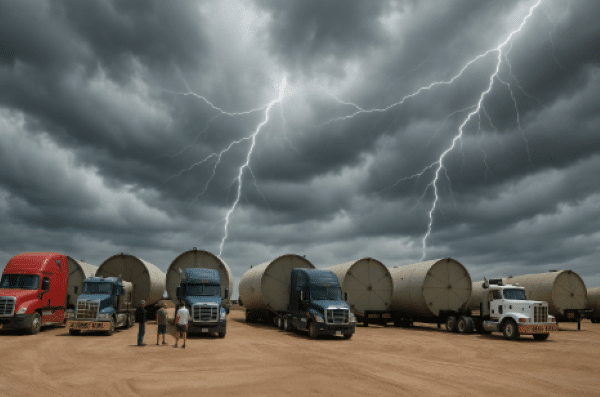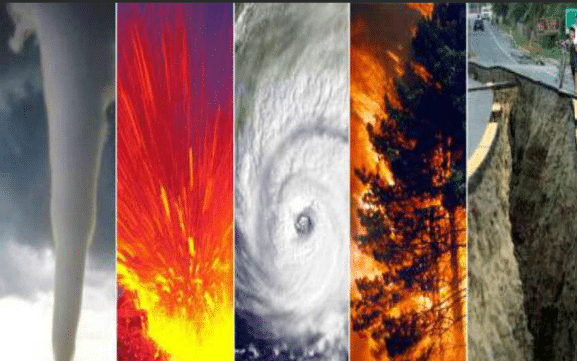Natural disasters such as hurricanes, earthquakes, floods, and wildfires pose significant risks to infrastructure, communities, and critical operations. Storage tanks, when strategically designed and deployed, offer robust solutions to mitigate damage and ensure operational continuity. This white paper explores how advanced storage tank systems, including those for water, fuel, and coolant, can safeguard critical infrastructure, support disaster response, and enhance resilience. Drawing on KBK Industries’ five decades of expertise, we highlight the engineering, materials, and strategic applications that make storage tanks indispensable for disaster preparedness and recovery.

1 Introduction
Natural disasters disrupt lives, economies, and critical infrastructure, often with cascading effects. From power outages to contaminated water supplies, the challenges are immense. Storage tanks, traditionally used for industrial applications, are emerging as vital tools for disaster mitigation. This paper examines how tanks designed for water storage, fuel storage for backup generators, and coolant storage for critical systems can
protect against damage from hurricanes, earthquakes, floods, and wildfires. By leveraging advanced materials, certifications, and custom engineering, KBK Industries provides solutions that enhance resilience and ensure operational continuity.
2 The Role of Storage Tanks in Disaster Mitigation
Storage tanks serve as critical assets in preparing for and responding to natural disasters. Their applications include:
• Water Storage: Potable water tanks ensure access to clean water during floods or hurricanes when municipal systems fail.
• Fuel Storage: Underground fuel tanks for backup generators maintain power for hospitals, data centers, and emergency services during outages.
• Coolant Storage: Tanks for propylene glycol or other coolants support cooling systems in data centers and industrial facilities, preventing overheating during power disruptions.
By storing essential resources securely, these tanks reduce dependency on vulnerable external supplies and enable rapid response to crises.
3 Engineering Resilience
Materials and Construction
KBK Industries employs advanced materials like fiberglass and stainless steel, which offer superior resistance to environmental stressors. Fiberglass tanks, for instance, are corrosion-resistant and lightweight, making them ideal for underground installation in flood-prone areas. Stainless steel tanks withstand extreme temperatures, suitable for wildfire-prone regions. Double-wall designs, certified to UL 1316 standards, provide secondary containment to prevent leaks during seismic events or storms.
Customization for Disaster Scenarios
Tanks can be tailored to specific disaster risks:
• Hurricanes: Tanks are designed with HS-20 axle loading to withstand heavy debris and flooding.
• Earthquakes: Seismic load engineering ensures tanks remain stable during tremors.
• Wildfires: Fire-resistant coatings and materials protect tanks in high-heat environments.
• Floods: Underground tanks with secure anchoring prevent flotation and damage.
Certifications and Standards
KBK’s tanks meet rigorous standards, including API Q1, API 12F, and UL 1316, ensuring compliance with safety and environmental regulations. AMPP NACE-certified technicians apply coatings to enhance durability, while ISO 9001:2015 certification guarantees consistent quality.
4 Case Studies
Hurricane Preparedness in Coastal Data Centers
A Southeast U.S. data center, located in a hurricane-prone region, partnered with KBK to install 10,000-gallon fiberglass coolant tanks for its propylene glycol-based cooling system. The tanks’ double-wall design and corrosion-resistant linings ensured reliability during Hurricane Delta in 2024, maintaining server operations despite widespread flooding.
Earthquake Resilience in Municipal Infrastructure
A California municipality deployed KBK’s UL 1316-certified underground fuel tanks to power backup generators for emergency services. Engineered for seismic loads, these tanks remained intact during a 6.8-magnitude earthquake, ensuring uninterrupted power for first responders.
Wildfire Protection for Industrial Facilities
In a wildfire-prone region of Colorado, an industrial facility installed KBK’s stainless steel water storage tanks with fire-resistant coatings. During a 2023 wildfire, the tanks supplied water for firefighting efforts, protecting the facility and nearby communities.
5 Strategic Deployment
Pre-Disaster Planning
Integrating storage tanks into disaster preparedness plans involves:
• Assessing regional risks (e.g., flood zones, seismic faults).
• Selecting tank materials and designs suited to specific threats.
• Ensuring compliance with local regulations and environmental standards.
Post-Disaster Recovery
Tanks facilitate recovery by:
• Providing immediate access to water and fuel for emergency response.
• Supporting temporary power and cooling solutions during infrastructure repairs.
• Reducing reliance on external supply chains, which may be disrupted.
6 Sustainability and Cost Efficiency
KBK’s tanks are designed for longevity, with warranties up to 30 years, reducing replacement costs. Underground installations optimize land use, while double-wall designs minimize environmental risks. Efficient coolant storage supports energy-saving cooling systems, aligning with sustainability goals. By investing in durable tanks, organizations avoid costly downtime and repairs post-disaster.
7 Conclusion
Storage tanks are more than industrial assets; they are critical components of disaster resilience. KBK Industries’ custom-engineered, certified tanks provide reliable solutions for water, fuel, and coolant storage, mitigating the impact of hurricanes, earthquakes, floods, and wildfires. By combining advanced materials, rigorous standards, and tailored designs, KBK empowers organizations to protect infrastructure and ensure continuity. Contact KBK Industries at www.kbkindustries.com to explore how our storage tank solutions can safeguard your operations against natural disasters.

